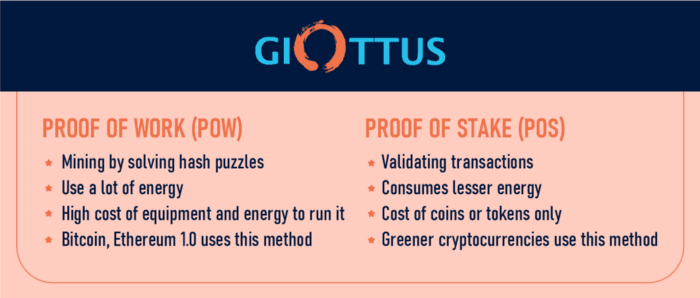By: Sruthi Menon
One of the greatest benefits of cryptocurrency is that they are decentralised. But the lack of a central authority responsible for verifying transactions also presents a challenge.
The cryptocurrency networks use blockchain to help ensure that no one spends the same money twice without a central authority keeping track.
In order to accomplish this, crypto networks use a ‘consensus mechanism’ to ensure that all the computers in the network recognise which transactions are legitimate.
‘Proof of work’ and ‘proof of stake’ are the two major types of consensus mechanisms, or algorithms, which allow blockchains to operate securely by allowing only genuine users to add new transactions.
Let us have a look at what these two mechanisms are, and how does it work differently.
In simple terms, what differs between ‘proof of work’ and ‘proof of stake’ is how they choose who can add transactions to the chain.
Proof of Work (PoW)
This mechanism is based on cryptography, which is an advanced form of mathematics. In 2009, when Bitcoin, the first-ever cryptocurrency was launched, the creators wanted a method to figure out a means to verify transactions without the involvement of a third party like a bank.
To facilitate this, the networks employ a validation method known as ‘proof of work’ to allow participants to agree on which transactions are valid.
Proof of work is based on network users’ ability to prove that a computational task is attained. Once the mathematical equation is solved, a new block on the chain is validated. Whoever answers the mathematics puzzle fastest, will create a cryptographic link between the previous and the current blocks and earn new crypto coins. This process is known as mining.
Cryptocurrencies like Bitcoin and Ethereum 1.0 and many others use this process.
When it comes to mining crypto and uploading blocks to the blockchain, each subsequent block refers to the prior blocks, ensuring an up-to-date ledger copy as the ledger keeps track of all transactions. The ledger is distributed to everyone to avoid tampering, ensuring that everyone sees the same version at the same time.
While the proof of work mechanism was established to be a potential way of maintaining a secure decentralised blockchain, it was soon proven to have many inefficiencies. The mechanism consumes a lot of electricity and the number of transactions it can handle at once was seen to be limited.

Proof of Stake (PoS)
While in proof of work, a computer solves a cryptographic problem to get awarded crypto rewards, proof of stake also works a similar way. It allows for the addition of transactions to the blockchain and earns crypto in exchange. But instead of performing tangible work, this concept is based on the existence of a verifiable stake in the ecosystem.
In the proof of stake mechanism, instead of having to expend physical or computational energy to verify transactions on the network, a user must simply prove ownership of some of the network tokens.
Unlike the high energy requirements of proof of work blockchains, novel consensus mechanisms like ‘proof of stake’ eliminate the need for mining. In the case of bitcoin, its technology is complex and not scalable, however, it was intended to be the way it is.
In PoS, the network selects a winner based on the amount of cryptocurrency each validator has committed to the pool and the time they have held it, rewarding those participants who have been holding their tokens the longest.
But is the future all about PoS? Maybe not. There are other consensus mechanisms as well those power top blockchain technologies that help it achieve scalability.
Both PoW and PoS solve the basic problem of verifying transactions without using a central authority. While the former makes it costly for an attacker to attack a cryptocurrency’s network, it also consumes lots of energy. Proof of stake doesn’t use nearly as much energy as proof of work, but it’s still not as secure or stable as proof of work at scale.
